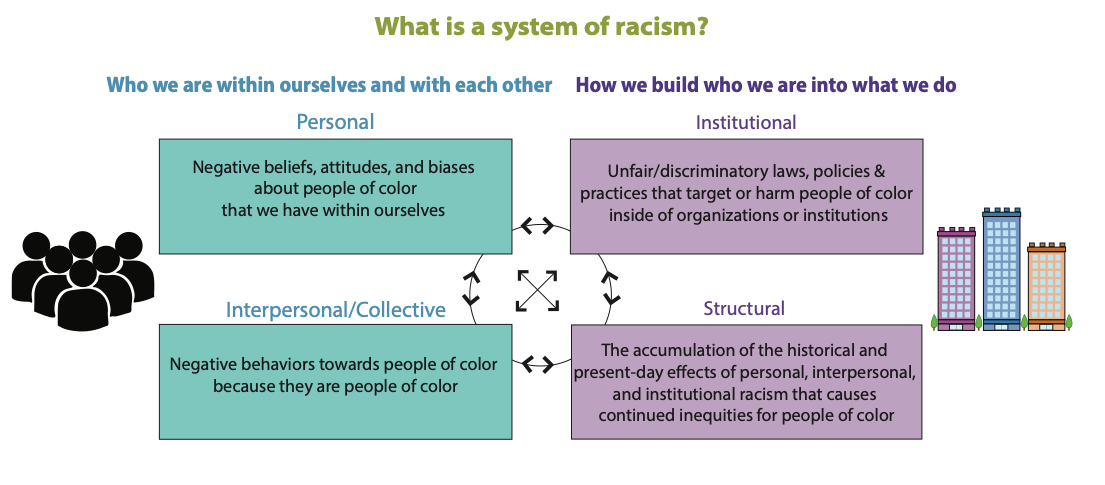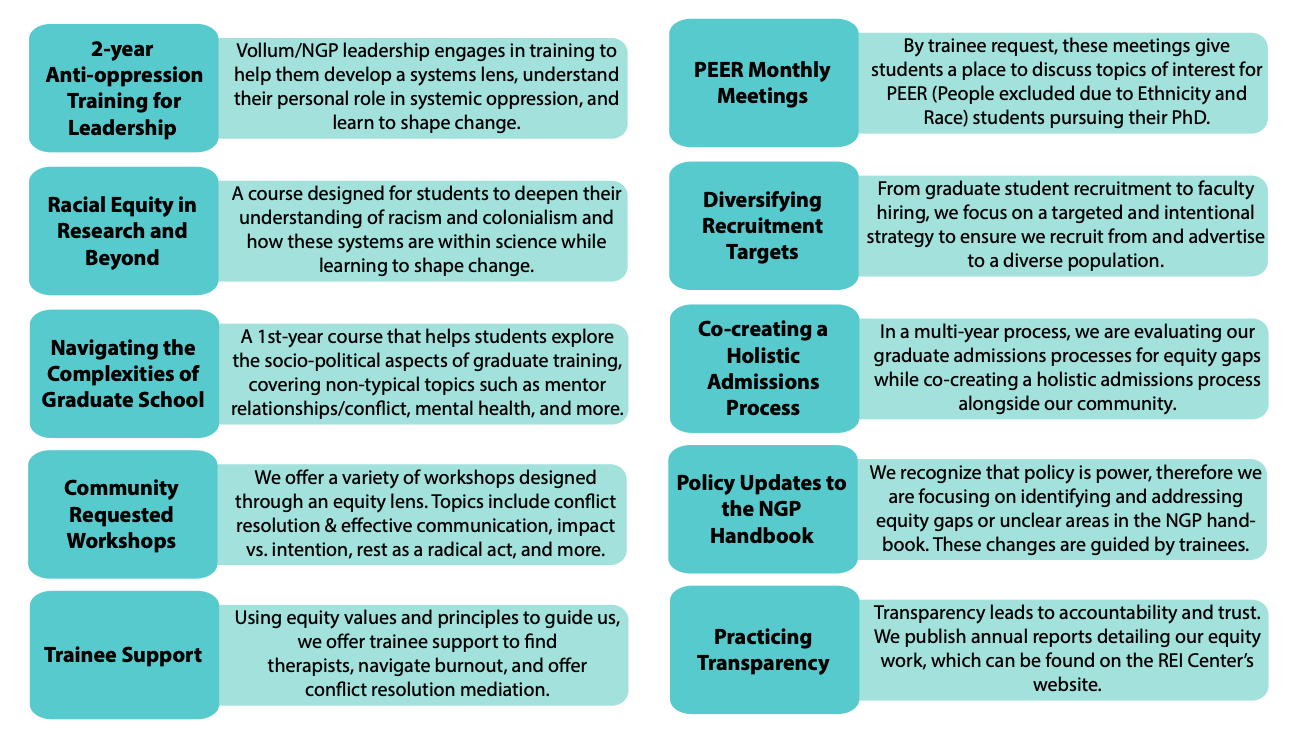Anti-Oppression Primer for International Applicants
At OHSU, we intend to establish ourselves as a national leading force in fostering an inclusive and safe environment where everyone can thrive and excel. In addition to our three missions to heal, teach, and discover, our fourth mission is to become a truly anti-racist and multicultural institution. The Vollum Institute and the Neuroscience Graduate Program (NGP) are in alignment with these missions; from innovative scientific discovery to training the next generation of critical thinkers, we aim to create an environment where every individual has the opportunity to reach their full potential.
As important as these core values are to creating a productive and supportive environment where everyone thrives, these values are oftentimes hopeful goals rather than the lived realities of many people across the scientific enterprise. Many groups remain underrepresented and excluded, explicitly or implicitly, from scientific research and education. These include women, individuals with physical or mental disabilities, those with social and economic disadvantages, and PEERs (Persons Excluded due to Ethnicity or Race)1,2.
The Vollum Institute and the NGP, in collaboration with the Racial Equity and Inclusion (REI) Center, aim to specifically determine and address the ways in which systemic racism (defined below) and other types of oppression show up in our scientific environment.
What are systems of oppression?
To understand why this underrepresentation exists, we can look at systems in our society that cause exclusion. A system is something that has many working parts that operate together to create a larger effect. When we are thinking of systems that exclude, we can think of systems of oppression. Systems of oppression use different working parts to create the larger effect of unfairly treating some groups poorly while other groups receive special/unfair advantages. Without concerted effort, people’s values, beliefs, and behaviors, as well as the rules around how organizations get things done, allow this difference in treatment to be perpetuated indefinitely3. Some examples of systems of oppression include but are not limited to systemic racism, patriarchy, ableism, classism, antisemitism, queer and trans antagonism, and the historical and current practice of colonialism. For a full definition of any of these terms, please visit the REI Center’s term glossary.
The four parts of the system
Each system of oppression uses the same four parts that create harm against specific groups of people. To describe these four parts, we will use systemic racism as an example (Figure 1). Systemic racism can be described as a system that results in the unequal treatment and opportunities based on skin color and perceived differences in cultural background. In this system, those with lighter skin get unfair advantages while those with darker skin face unjust treatment. The four parts of this system are: 1) Personal racism (e.g., Negative beliefs, attitudes, and biases about people of color that we have within ourselves). 2) Interpersonal racism (e.g.,Negative behaviors towards other people because they are people of color). 3) Institutional racism (e.g., unfair/discriminatory laws, policies, and practices that target or harm people of color inside of organizations or institutions ). 4) Structural racism (i.e., the accumulation of the historical and present day effects of personal, interpersonal, and institutional racism that causes continued inequities for people of color). To get a deeper understanding of systemic racism, please watch this video titled “Systemic Racism Explained,” which outlines some of the ways racism shows up in the U.S. including redlining in the housing market, differences in funding for education, and incarceration rates3.

There are many reasons why understanding that systems of oppression are active in the US may be important for international applicants. These reasons include:
- Cultural awareness and interaction: Understanding these systems helps international students contribute to the welcoming and safe environment we aim to create at OHSU and within the NGP. This understanding helps students engage in meaningful conversation, challenge stereotypes, and work with others across different cultures.
- Awareness of social dynamics: Although there may be broad familiarity of some systems of oppression, systemic racism is oftentimes a less familiar system for many international students. As with any system or culture, it is important for students to broaden their understanding as it can help give context to social dynamics students may encounter and can help with understanding societal issues that certain groups face.
- Personal safety and well-being: Awareness of systems of oppression can help students identify potentially unfair treatment they may face and can help prepare students to take protective measures to keep themselves safe. We take student’s safety and well-being seriously and are here to help students navigate any unsafe or unfair situation.
- Engaging in Social Justice Efforts: Understanding systems of oppression can empower international students to work alongside our active student body in engaging in social justice work! Students may be interested in working alongside the Alliance for Visible Diversity in Science (AVDS) or our local SACNAS chapter SACNAS OHSU, which are two student organizations that work towards fostering an inclusive and equitable scientific environment.
Our goal is to create an anti-oppressive environment, which means we work on identifying and addressing the ways in which these systems of oppression show up in our scientific environment. As mentioned before, systems of oppression have four working parts: Personal, interpersonal, institutional, and structural. With that understanding, we structured our work and positions to make sure we attend to each part of the system.
The REI Center has two leadership positions focused on all parts of a system of oppression:

The Director of Community Transformation focuses on addressing personal and interpersonal aspects of systemic racism/oppression (Figure 2). Their role involves identifying cultural values incompatible with equity while developing actions to align values and norms for an inclusive environment. They provide anti-racism/anti-oppression education to students, postdocs, and faculty, while helping people understand how certain personal beliefs and behaviors contribute to systemic issues. By transforming the culture, they aim to create an equitable space.
The Director of Innovative Policy focuses on institutional and structural forms of systemic racism/oppression (Figure 2). They are responsible for identifying inequitable policies and procedures within the Vollum/NGP and creating and implementing policies that promote equity. This position focuses on reviewing and updating policies that affect how the Vollum/NGP recruits and retains faculty, students, post-docs, and other research staff.
Figure 3 gives a brief overview of our current efforts. We continue to expand and/or build on these efforts daily and plan to engage in new efforts over time.

We hope that this primer provides a starting point for understanding systems of oppression within the U.S. and provides context to how we work towards addressing it in our program. Advancing racial equity and anti-oppression benefits everyone and it is our entire community’s responsibility to advance racial equity and anti-oppression. Our overall aim is to empower our leadership and our community members to become active agents of change in order to truly live our values and manifest our missions at OHSU.
We see these objectives as only the beginning steps of our anti-racism/anti-oppression work. This work involves continual assessment, (re)evaluation, and ongoing openness to change and improve. We are committed to transforming our environment so that it may truly reflect our values and create a thriving, inclusive, anti-racist, and multi-cultural institution.
In-text references: